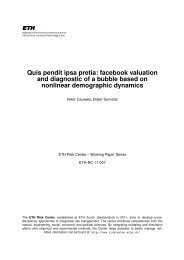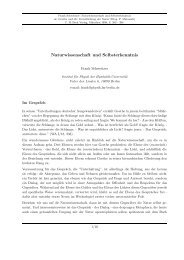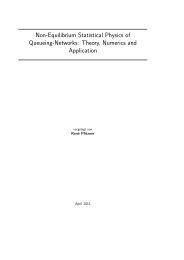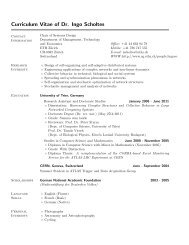Using Laboratory Experiments to Study Law and Crime - Chair of ...
Using Laboratory Experiments to Study Law and Crime - Chair of ...
Using Laboratory Experiments to Study Law and Crime - Chair of ...
Create successful ePaper yourself
Turn your PDF publications into a flip-book with our unique Google optimized e-Paper software.
in a theory <strong>and</strong> our expectation that the theory will be upheld in situations in which it is meant <strong>to</strong>apply. In turn, when we underst<strong>and</strong> the mechanisms at work we are in a better position <strong>to</strong>develop innovations for the field.<strong>Labora<strong>to</strong>ry</strong> experiments have particular characteristics that make them valuable fortesting causal theory <strong>and</strong> for disentangling causal mechanisms. Below we discuss some <strong>of</strong> thesecharacteristics <strong>and</strong> their associated opportunities <strong>and</strong> pitfalls.RANDOM ASSIGNMENT<strong>Labora<strong>to</strong>ry</strong> <strong>and</strong> field experiments share a common characteristic – the use <strong>of</strong> r<strong>and</strong>omassignment <strong>to</strong> an experimental condition. R<strong>and</strong>om assignment is a feature <strong>of</strong> experiments thatincreases our confidence in drawing conclusions about causality. Uggen argues that “thedisciplinary field <strong>of</strong> ‘criminology’ is largely organized around a single dependent variable. Weobserve the effect – conditions <strong>of</strong> crime <strong>and</strong> noncrime – in an observational sample, <strong>and</strong> thenmake heroic statistical efforts <strong>to</strong> disentangle the myriad forces that give rise <strong>to</strong> is. . . . [I]t ismuch more sensible for a researcher <strong>to</strong> actively manipulate a cause <strong>and</strong> then <strong>to</strong> observe itseffects – <strong>to</strong> do something <strong>and</strong> watch what happens. In doing so, researchers can compare theeffects <strong>of</strong> the cause they subject <strong>to</strong> treatment (t) with the counterfactual case in which some othercause or a control condition is applied (c)” (Uggen, 2008: 182; see also Freedman, 1991: 292,306 f; <strong>and</strong> Berk, 2004: 98, 102). R<strong>and</strong>om assignment allows us <strong>to</strong> conclude that the effects weobserve are due <strong>to</strong> the manipulation <strong>and</strong> not <strong>to</strong> some unobserved characteristic <strong>of</strong> individuals.This is because individual traits are r<strong>and</strong>omly distributed across the experimental conditions (<strong>and</strong>the researcher can be confident that subjects were exposed <strong>to</strong> the intended treatment).4







